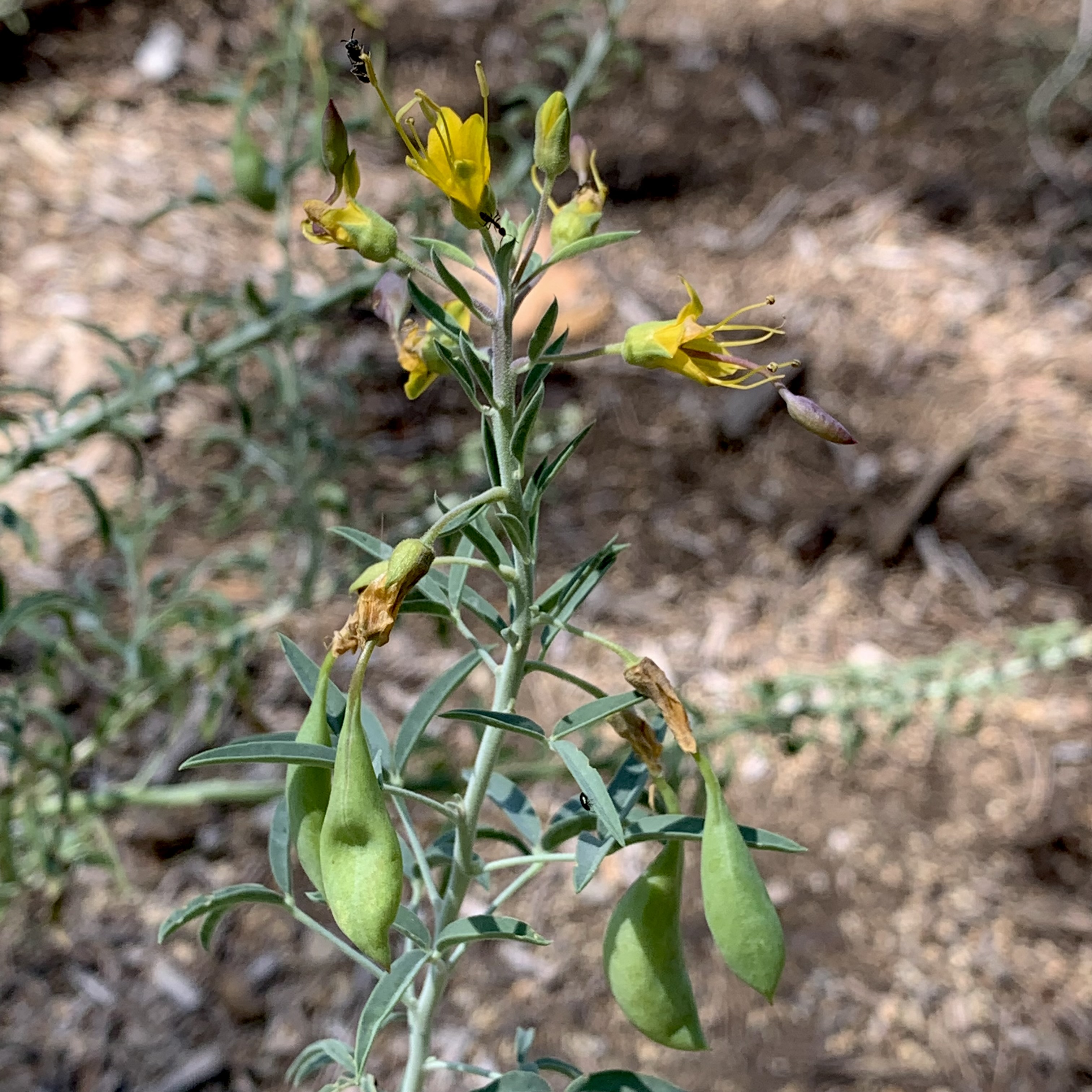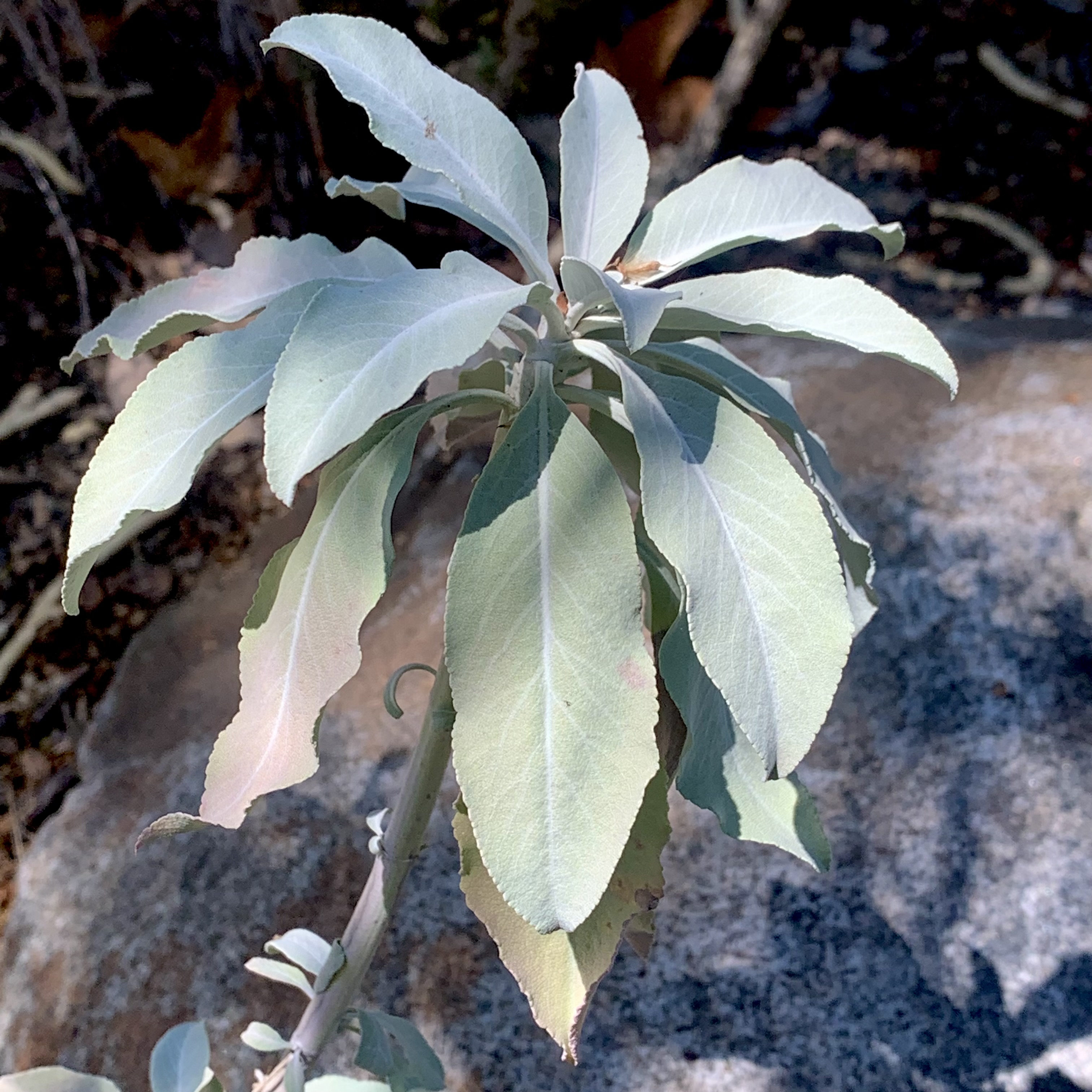Chaparral Community
Prostrate chamise - Adenostoma fasciculatum 'Black Diamond'
South Coast: chaparral, dry slopes, ridges. Produces seedlings from fire-activated soil-stored seeds. Litter creates fuel loads that can support a moderately intense fire within 15 years! Chemical composition of foliage includes high energy waxes, resins, oils, terpenes, and fats.
Red shank - Adenostoma sparsifolium
Transverse Ranges: dry slopes, chaparral. Tea made from small branches were used to treat toothache and to clean wounds and sores. An unknown flavonoid or phenolic acid from this plant is effective against the bacteria that causes tooth and gum disease. Sugar from the honeydews produced by aphids caused tooth decay and gum disease.
White alder - Alnus rhombifolia
California: streams. Male catkins may have been eaten raw or cooked and cambium and seeds were eaten in northern California. The bark of this tree may have been used to treat rashes, wounds and fevers. The brown and red basketry patterns were made with roots and bark was used to dye fern strands. Fishermen were taught to stain their bodies red with dye, from chewing the bark, to help them trick and catch salmon
Dogbane hemp - Apocynum cannabinum
South Coast: streams, springs. Fibers were used to make string for bows, sacks, fishing equipment, poultices and casts. The roots were used to treat intestinal and bronchial diseases but has risk of toxicity. In Chumash folklore, Coyote used his magic power to twist hemp cord very fast on his thigh to make fishline for all the people.
Kinnikkinnick/Red bearberry - Arctostaphylos uva-ursi x imbricata
Mugwort - Artemisia douglasiana
California: open to shady areas, drainages. The seeds and peeled shoots were often eaten raw. The juices from the leaves were applied to poison oak infections and to irritation from stinging nettles. Stems and leaves were put under pillows to promote pleasant dreams. Leaves were also chewed from toothaches.
Red Columbine - Aquilegia formosa
South Coast: stream banks, oak woodland. Root decoction was used against diarrhea, indigestion, and coughs. Chewed up roots or leaves were applied to bee stings and seeds were used as a diuretic, paste made to treat lice.
Emory's Baccharis - Baccharis emoryi
South Coast: sandy edges of rivers, washes. The fibers were used in coil basketry and the wood was used for planting sticks and for firewood. The "down" were put into fires by children to produce a sudden burst of flame. Pith was used to make "pea-shooters" and stems/twigs were used to make te shooters.
Western redbud - Cercis occidentalis
Peninsular Ranges: foothill woodlands, forests. The appearance of the flower were a welcomed as a sign of Spring. The buds were used to relieve diarrhea. This plant was burned annually to encourage straight shoots for bows and basketry. The pods and seeds were roasted in ashes to be eaten
Summer holly - Comarostaphylis diversifolia ssp. diversifolia
Transverse Ranges: chaparral. This plant produces white flowers followed by edible warty looking fruits. Their flowering occurs later than most shrubs and were a valuable resource for insects and hummingbirds. In folklore, Summer Holly combines some of the best attributes of manzanitas, with their glorious bloom, and toyons, with the late summer spectacle of birds dining on the vivid red fruits.
California fuschia - Epilobium sp.
South Coast: dry slopes, ridges. Dried powdered leaves were sprinkled directly on wounds or boiled as a wash for cuts, sores and sprains. Epilobium also provides browse for deer. This plant is an important nectar source for hummingbirds, bees, and butterflies.
Montana de Oro Wood Strawberry - Fragaria vesca 'Montana de Oro'
Peninsular Ranges: forest. Leaves were used fresh or dry to make leaf tea that was used to cure diarrhea. The fruits were a choice of delicacy fresh or dried. A vigorous selection from Montana de Oro State Park on the San Luis Obispo coast.
Flannel bush - Fremontodendron californicum
California: chaparral, oak/pine woodland, rocky ridges. The inner bark was used for poultice sores. However, the bristles found on the leaves can detach in the skin and cause dermatitis. Seeds were parches and ground for flour from which mush cakes could be made. The stems were used as building materials for fences to keep rodents out and for firewood and torches.
Toyon - Heteromeles arbutifolia
California: chaparral, oak woodland. Red berries were eaten to avoid hunger in the wintertime and were usually toasted with a hot rock in a basket or boiled, then baked for 3 days, boiled and roasted for 2-3 days. The wood of the tree were used for arrows, tools, and mends hairpins while the berries were a valuable source of dye. A decoction from mashed leaves were used to bathe sores.
Bladderpod - Isomeris arborea

South Coast: coastal bluffs, hills, desert washes. Bladderpod was an important source of food for natives. Pods, flowers and seeds were cooked and eaten. However, this plant is NOT safe to eat until cooked adequately to destroy glucocapparin that can cause irritation and rashes. Gulcocapparin gives the plant a pungent taste.
Coastal pricklypear - Opuntia littoralis
South Coast: coastal sage, chaparral. The fruits were edible and often eaten while the pads could be cooked and then eaten as well. Additionally, the fruits could be boiled and fermented to make an alcoholic beverage. Poultices from inside of the pads were used for wounds, arthritis, and swelling/pain from bites. The sharp spines of the cactus were used for tattooing.
California black oak - Quercus kelloggii
California: Valleys, woodland, coniferous forests. In folklore, Mistletoe is a parasitic flowering plant, often found on Black Oak. In the winter, when canopies are leafless and dormant, native people believed that the life-spirit of the tree retreated to the mistletoe. Druids of Europe held a similar belief about deciduous oak.s Bringing mistletoes into our home for winter holidays may have originated from their preparations for the rebirth of Spring.
Golden currant - Ribes aureum
South Coast: alluvial areas, forest edges. Flowers of this species tend to have a spicy fragrance that can be detached across the garden late in the evening. In pemmican, a staple of the native diet, was made from dried currants or berries which were pounded and mixed with meat and animal fat, formed into cakes, which made an important portable food source that could be stored.
Fuschia flowered goosberry - Ribes speciosum
South Coast: coastal-sage-scrub, chaparral. The berries were mixed with meat and fat for pemmican. This is another source of making portable and storable food. Arrow shafts were made from the straight stems of this plant.
Sugar bush - Rhus ovata
South Coast: slopes, canyons, chaparral. Leaf teas were used for treating colds. The fruits were eaten or mixed with water for "lemonade" and the berries could be sucked on to alleviate thirst. The fallen leaves were a good source to produce brown dyes. Oils extracted from the seeds were used to make candles.
Coulter's Matilja Poppy - Romneya coulteri
South Coast: dry washes, canyons. The stalks produced a watery sap that could be drunk. This plant is also called "Queen" of California wildflowers and "Fried Egg Flower" and is the largest of any native plant growing 6-12 inches across. They are finicky and aggressive in a garden! A heady fragrance of fresh apricots wafts from the blooms, but look for bees before you sniff!
California rose - Rosa californica
California: moist areas, stream banks. The petal were smashed in cold water for colic, teething, and constipation in babies. Though labor intensive, the petals were dried and crushed to make baby powder. Rose hips were eaten fresh, used for teas, or dried and stored for later use as food.
Interior Rose - Rosa woodsii
Peninsular Ranges: chaparral. A decoction was made from the roots and was used in moderation to stop diarrhea. The roots and bark were also used for colds and general debility. Like the California Rose, rosehips from this plant were eaten fresh or died for later use as well as used to brew a refreshing tea.
Sand-bar willow - Salix exigua
California: marshes, streamsides. Straight trunks were used to build house frames, bows and arrows. The branches with leaves were used for granaries and baskets. Willow bark was woven into belts, skirts, as well as bags and nets used for gathering fruits or acorns.
White sage - Salvia apiana

South Coast: coastal-sage scrub, chaparral. Leaves were sucked on for few minutes to relieve sore throats. A shampoo was made by rubbing fresh leaves between the palms of hands with water. In folklore, "to smudge white sage, say a prayer, pick a small branch, let it dry for a few days, then smudge it slowly while praying."
Cleveland sage - Salvia clevelandii
South Coast: chaparral, coastal scrub. The name Salvia comes from the latin salveo meaning "I save" in reference to the purported life-saving abilities of this genus of plants. Leaves of any fragrant sage can be used in moderation for tea or as a spice in flavoring food. Hummingbirds, bees, butterflies and other insects collect nectar from the flowers.
Blue elderberry - Sambucus cerulea
California: streambanks, open places in forests. The fruits of this plant are toxic when fresh but when dried, can be eaten raw or cooked and have a sweet flavor. One teaspoon of flowers, fresh or dried, added to one and a half cups of boiling water and sugar, steeped for 5 minutes could be drunk for flu and colds. The branches were used to make clappers or flutes and fruits were used to produce black dye for basketry.
Alaki Sacaton, Dropseed - Sporobolus airoides
Transverse Ranges: alkaline areas. Masses of shimmering pink stalks add texture, movement and color to a garden during the long days of summer. Loss of fired used by native people to maintain desert grasslands may explain disappearance of this grass in some areas.
Mission manzanita - Xylococcus bicolor
